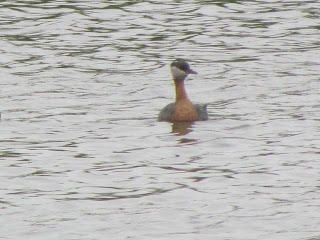 |
| Observation Hut at Frank Lake |
I started my morning as normal at Burnsmead, and what a
beautiful morning it was. I followed the
trail next to the river in a northerly direction towards the park Bankside,
recording 24 species but no lifers or
new birds for the trip. The highlight of
the morning was watching a Merlin (Falco columbarius), unsuccessfully, go
after a Northern Flicker (Colaptes auratus). The Flicker, though slower
than the bird of prey, kept evading it by flying a circuit in and out and
between branches of a tree. All the
while, the deafening calls of a group of Black-billed
Magpies (Pica hudsonia) tried
their best to distract and confuse the raptor. In the end, the Merlin gave up the chase and the Flicker survived another day.
In the afternoon my uncle took me to one of the primary
birding hotspots in the province, Frank Lake, located about 30 miles (50 km) south of
Calgary. I enjoyed the long drive along
highway 23 as it allowed me to see more of the beauty of Alberta, but after an
hour or so we turned off of the highway onto a dirt trail and drove for about
1.5 miles (2.4km) to the end of that trail and a very large lake came into view. I followed a wooden boardwalk to a lookout
hut. While on the boardwalk I got my
first lifer, a Marsh Wren (Cistothorus
palustris). At the hut four
photographers were busy photographing the spread of birds before them, one of
them was trying to photograph the American
White Pelican (Pelecanus
erythrorhynchos) fishing. The lake
was massive and many of the birds were really too far to identify but the
photographers, one in particular, were helpful in pointing out a few birds to
me and also directed me to the best spot along the lake to see my targeted
birds.

Because of following their
directions I saw birds such as the grebes - Horned (Podiceps auritus), Eared (Podiceps nigricollis) and Western (Aechmophorus occidentalis)
also one of the main birds I wanted to see, White-faced Ibis (Plegadis chihi), sadly I cannot remember their
names, I blame it on aging, but would like to thank them once again.
I really enjoyed my trip to this Important Bird Area, it is
a fine example of conservation at work and I am looking forward to visiting it
again on my next trip to Calgary. At the
end of day 8 I saw 11 new birds for the trip, six of which were lifers.
Trip Tally
New Species for the Day: 11
New Lifers for the Day: 6
Total Species for the Trip: 92
Total Lifers for the Trip: 63
Horned Grebe; Eared Grebe; Western Grebe; Black-necked
Stilt;
American Avocet;
Killdeer; Long-billed
Dowitcher; Black Tern; White-faced Ibis; Barn Swallow;
Marsh Wren
 |
| Frank Lake |
 |
| Pied-billed Grebe |
 |
| American Avocet (Lifer) |
 |
| Eared Grebe (Lifer) |
 |
| Eared Grebe (Lifer) |
 |
| Eared Grebe (Lifer) |
 |
| Horned Grebe Juvenile (Lifer) |








































